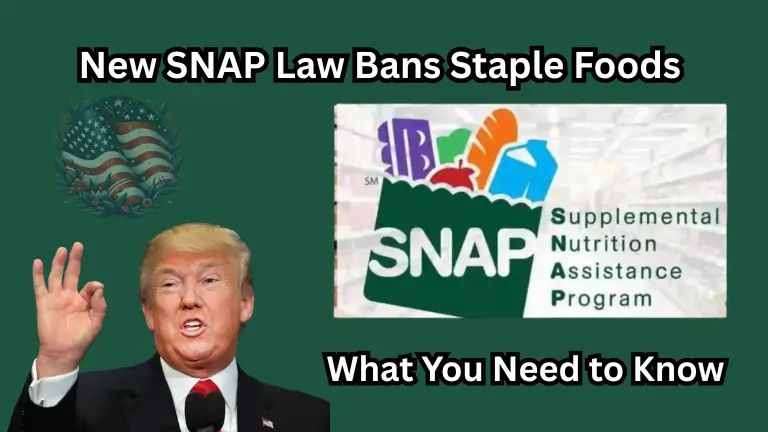SNAP Law Bans Staple Foods: In a move that could reshape the way millions access food assistance, a new SNAP law is being contemplated to ban the purchase of certain staple foods with SNAP benefits after 60 years of the program’s existence. This potential change, spearheaded in states like Idaho and under discussions at the federal level, could restrict the purchase of items such as candy and soda for SNAP recipients. Here’s what you need to know about this controversial development, the changes proposed, and its potential impact on millions of households.

What Is the New SNAP Law?
The Supplemental Nutrition Assistance Program (SNAP) has long allowed low-income households to purchase “any food or food product intended for human consumption.” However, recent legislative efforts, such as House Bill 109 passed in Idaho, seek to ban the purchase of candy and soft drinks with SNAP benefits. Lawmakers argue that this move will promote healthier eating habits among SNAP beneficiaries by restricting access to nutritionally poor foods.
Key Points:
- Idaho Initiative:
Lawmakers in Idaho recently passed a bill requiring Governor Brad Little’s signature to ban the use of SNAP funds for candy and soda. The bill passed with significant majorities in both the Senate (25-10) and the House (48-20). - Nationwide Pressure:
The measure reflects a broader push, with similar proposals like the Healthy SNAP Act introduced by Republican Rep. Josh Brecheen from Oklahoma. This act aims to restrict purchases of soft drinks, candy, ice cream, and prepared desserts with SNAP benefits. - Federal Involvement:
For the Idaho law to take effect, it still requires approval from the United States Department of Agriculture (USDA) or the necessary waiver each year until granted.
How Could This Affect SNAP Beneficiaries?
Impact on Idaho and Nationwide:
- Idaho Snapshot:
In Idaho, SNAP benefits currently serve approximately 130,900 residents, about 7% of the state’s population. If enacted, the law would affect the way beneficiaries use their funds, limiting their choices for snack foods and sugary beverages. - Nationwide Scope:
Nationwide, SNAP benefits serve around 42.1 million people per month. Similar measures are under consideration in at least 10 other states, including Arizona, Arkansas, Iowa, Missouri, Montana, Tennessee, Texas, Utah, and West Virginia.
Potential Consequences:
- Nutritional Benefits:
Advocates argue that limiting purchases of candy and soda will encourage healthier diets and reduce diet-related diseases. - Controversy Over Choice:
Critics, however, contend that such restrictions undermine the principle of personal choice and could stigmatize low-income households by implying they cannot be trusted to make their own nutritional decisions. - Administrative Challenges:
The law would require states to refine definitions (such as what qualifies as “candy”) and regularly apply for USDA waivers, adding an administrative layer to the SNAP program.
The Debate Over Food Choice in SNAP
This debate touches on both public health and personal freedom. Currently, SNAP funds can be used to purchase most food items, except for non-food products like alcohol, tobacco, and hot prepared foods. The new proposals, however, seek to use nutrition as a criterion for eligible purchases—a significant shift in policy that has both supporters and detractors.
Perspectives:
- Health Advocates:
Proponents argue that banning candy and soda will lead to better dietary choices, potentially reducing obesity, diabetes, and other related illnesses among SNAP recipients. - Consumer Rights Groups:
Opponents argue that such restrictions could limit access to comfort foods, particularly for individuals in food deserts or those facing economic hardship, and may be seen as paternalistic.
What Changes Are Expected in Eligibility Criteria?
Beyond food bans, there is growing discussion around updating SNAP eligibility and spending criteria to reflect modern nutritional science. New SNAP laws and amendments could eventually extend to additional items considered “junk food,” leading to a broader shift in the program’s structure and benefits.
Recent proposals include:
- Nutritional Value Screening:
Future laws might mandate that all eligible items be assessed based on nutritional value. - Annual Waiver Applications:
States may be required to apply annually for exemptions from these restrictions if they wish to retain broader purchasing options for SNAP recipients.
Final Thoughts
The proposed ban on staple foods like candy and soda under the new SNAP law represents a significant shift in food assistance policy. While intended to promote healthier eating habits, this move raises important questions about personal choice, administrative feasibility, and the broader implications for millions of beneficiaries. As states and federal agencies deliberate on these changes, it’s essential for SNAP recipients and advocates alike to stay informed and engage in the conversation.
FAQs
Q1: What does the new SNAP law propose to ban?
A1: The law proposes to ban the purchase of candy and soda with SNAP benefits, starting with Idaho and potentially extending to other states.
Q2: Who will be affected by this law?
A2: The law will affect SNAP recipients, with Idaho currently serving about 130,900 residents and nationwide benefits reaching over 42 million people monthly.
Q3: Why are lawmakers proposing this ban?
A3: Lawmakers argue that banning candy and soda will promote healthier eating habits and reduce diet-related health issues among low-income households.
Q4: Does the law apply to all food purchases with SNAP benefits?
A4: No, currently SNAP benefits can be used for most food items, but this proposal specifically targets candy, soda, and potentially other junk foods.
Q5: What must happen for the law to take effect?
A5: The law requires the signature of Idaho’s governor and approval or a waiver from the USDA before it can be implemented.
As a finance news writer at sirfal.com, I specialize in breaking down complex economic trends, market updates, and investment strategies into clear, actionable insights. My mission is to empower readers with the knowledge needed to make informed financial decisions. Thank you for engaging with my articles; I hope they add value to your financial journey.